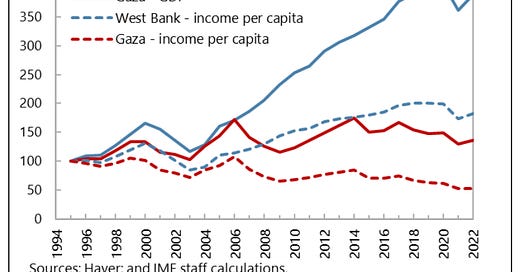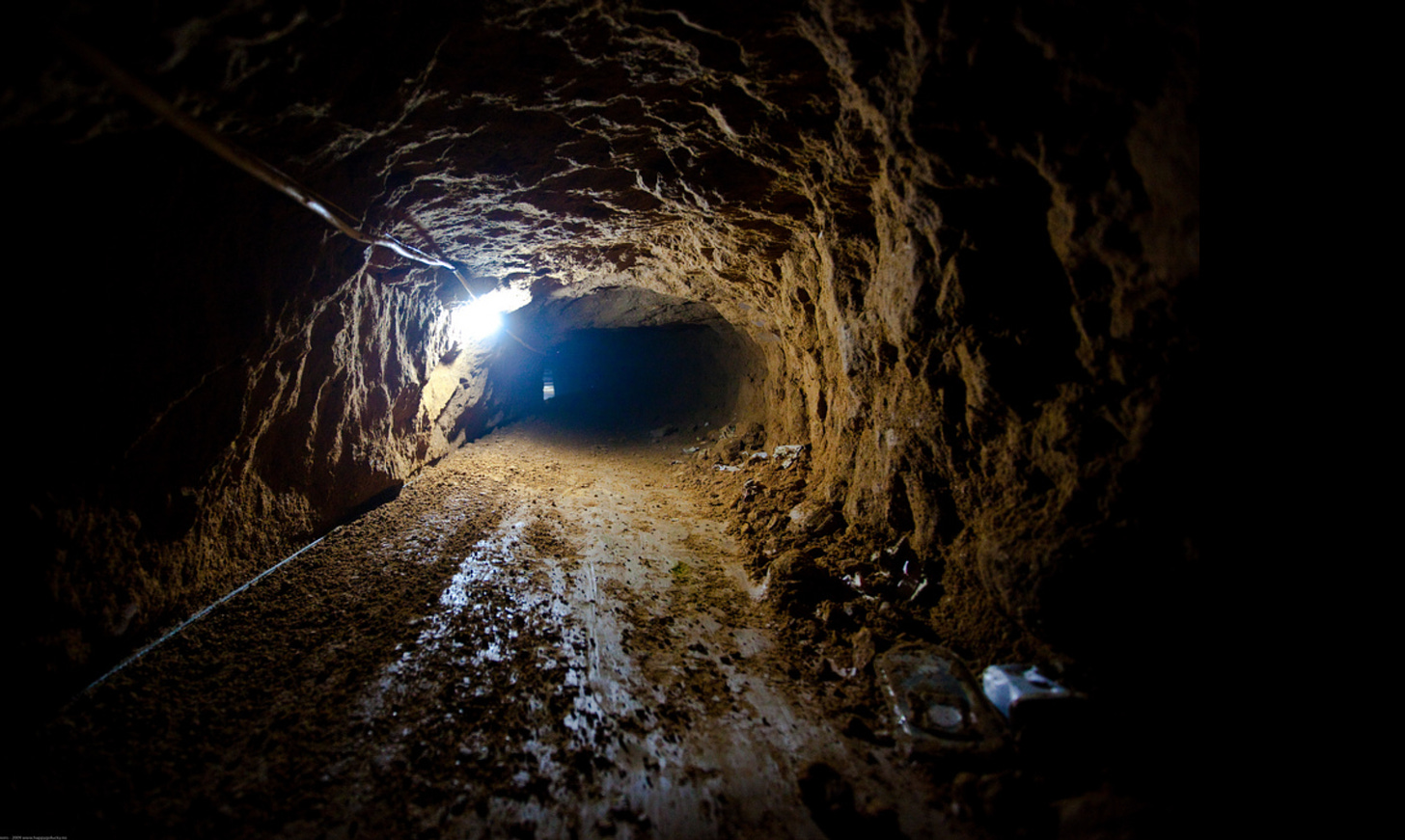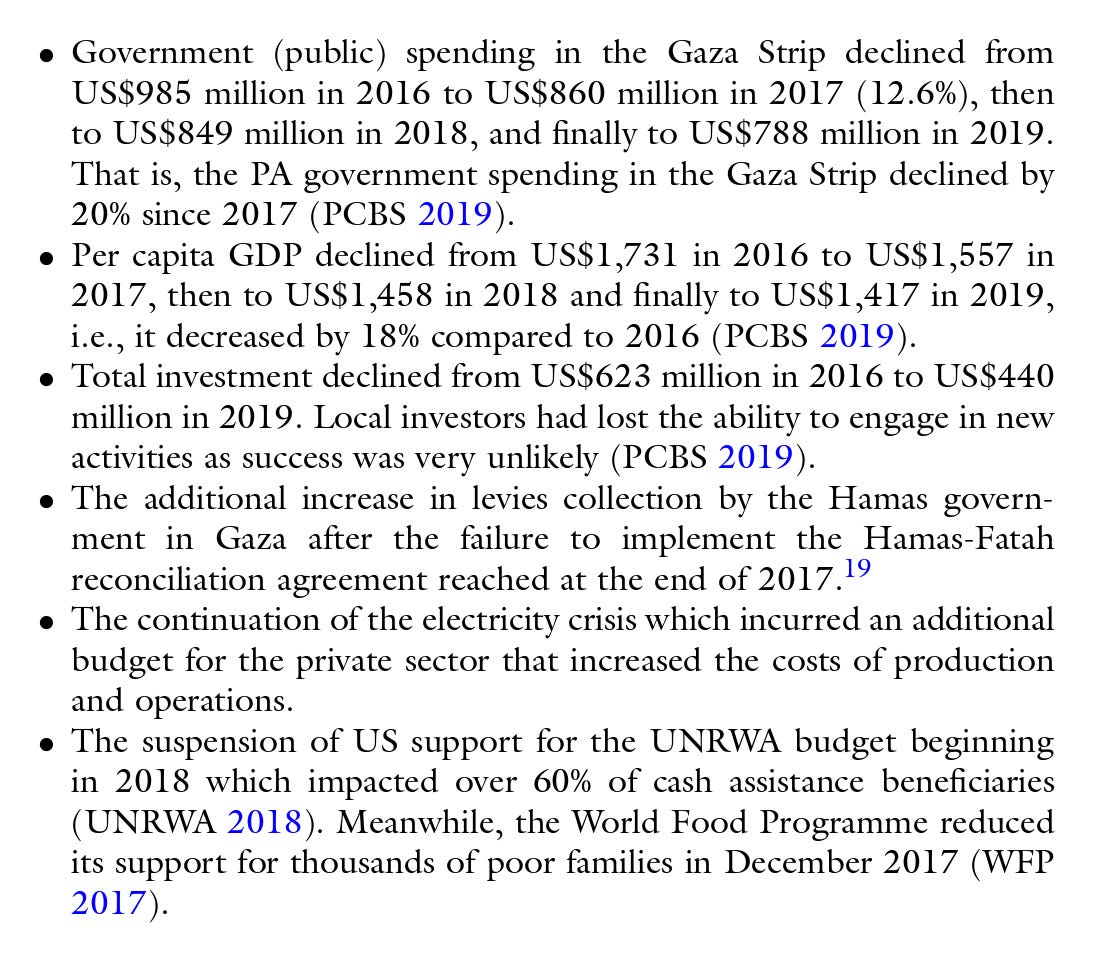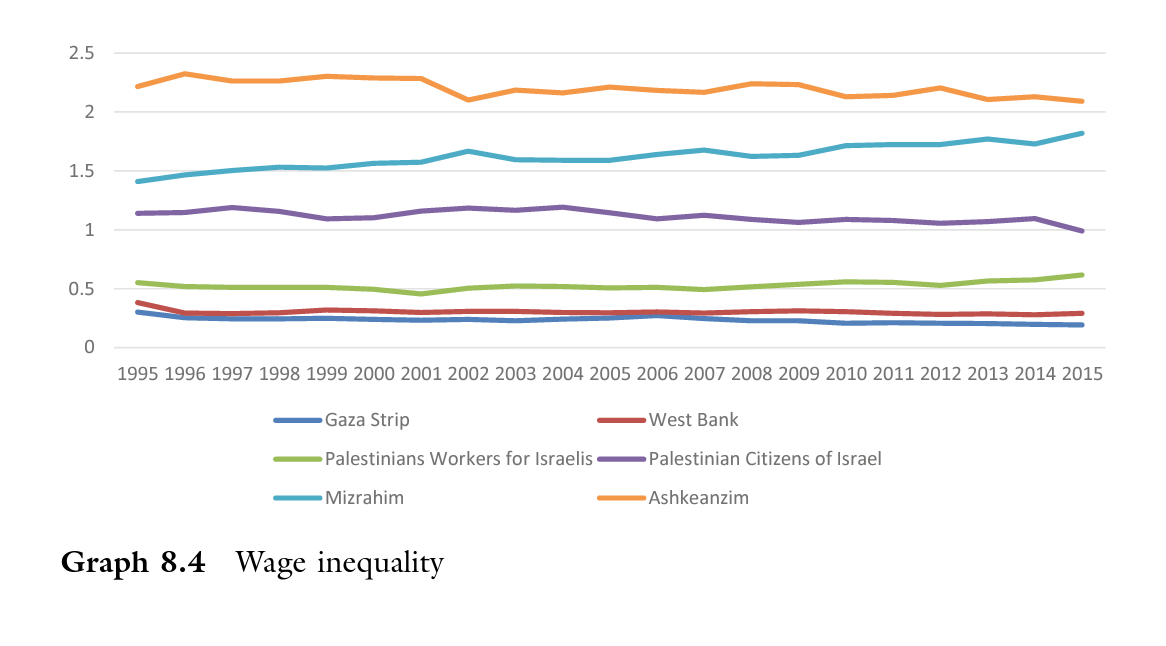In preparation for a massive retaliatory operation against Hamas, Israel has instructed the population of Northern Gaza to evacuate. Effectively, the IDF put 1 million people on notice of imminent destruction. We know why the IDF issued the order. It wants to minimize civilian casualties. But apart from the practical and humanitarian question of where such a huge mass of people are supposed to go and how they are to support themselves, we must face the question: What kind of place is Gaza, that it can be subject to such instructions? How can a territory that is home to more than 2 million people be disposed of in this way? Why are there no powerful interests that react against the ruthless logic of a military campaign that simply designates a city for destruction? How did Gaza and its people become so isolated, so absolutely objectified?
**
Gaza was not always like this. Favorably placed on the Eastern mediterranean, Gaza has been a place of human settlement for more than 5000 years. A natural stopping point for travelers and merchants heading back and forth between Africa and Asia, it featured prominently in the Old Testament. Gaza was a member of the Philistine confederacy of five cities along the coastal plain. Gaza was visited by King David and Alexander the Great. Falling under Ottoman rule in 1516, Gaza was a major battlefield in the struggle for the control of Palestine in World War I. Only after three major engagements did the British finally manage to capture it in 1917.
Under the Mandate, during the riots of 1929 the small but long-established Jewish communities was evacuated to Tel-Aviv for fear of massacre. In 1948, as the British withdrew, the Egyptian military occupied the coastal strip around Gaza. The population at the time consisted of roughly 80,000 Palestinians in four small towns: Gaza, DeirAl-Balah, Khan Younis, and Rafah. In a matter of weeks this small strip of land became a place of refuge for well over 150,000 refugees fleeing from from villages and towns in the south of Palestine in the face of the Haganah’s ethnic cleansing. The effect was to triple the population and to create Gaza as we know it today, an overcrowded, haven for refugees.
After 1948, the UN set up an agency UNRWA to support the Palestinian refugees in Jordan, Lebanon, Syria, and the West Bank, as well as in Gaza. For the following two decades under Egyptian rule, Gaza’s population had access to Egypt for work and study.
Then came the 1967 war and the vast expansion of Israeli control into the Sinai and West Bank. The first Israeli census in Gaza in 1967 counted a population of 394,000, of which at least 60% were refugees. To govern the territory at arms length, Israeli adopted Moshe Dayan’s policy of “open bridges”. The military minimized its footprint and Gaza and the West Bank were integrated as far as possible into the Israeli economy. In 1981 a formal border and border checkpoints were established between Gaza and Egypt for the first time, running through the border town of Rafah. Meanwhile, attracted by much higher wages, by the 1980s approximately 45 percent of the Gazan workforce was employed in Israel.
The result, given the relative dynamism of Israeli economy, was considerable growth in incomes in Gaza. But it was also in this period that Sara Roy coined the phrase de-development. Though income levels in Gaza were rising, as Roy pointed out in 1987, it was not developing. Indeed, it was being systematically de-developed. Palestinian workers were sucked into low-wage work in Israel, undermining Palestine’s own business sector and the standing of Palestine’s own landowning and bourgeois interests. Between 1970 and 1985, even as the GDP of the West Bank and Gaza increased, total employment in the Palestinian economy stagnated. The result of surging real incomes and stagnant production in the Palestinian territories was a yawning trade deficit with Israel.
This highly unequal exchange was shot through with frustrations and resentment. Whereas the labour market for Israeli insiders was tightly regulated with strong rights for workers enforced by powerful trade unions, Palestinian labour functioned as a flexible and disenfranchised reserve army that could be hired and fired at will. The conditions of discrimination and low pay were compounded by Israel’s economic crisis in the early 1980s, the consequences of which fell most heavily on the Palestinian underclass. In 1987 these resentments exploded in the first Intifada.
In December 1987 a vehicle carrying Palestinian workers in Gaza’s Jabalya refugee camp was hit by an Israeli truck, killing four. Out of the protests that followed and clashes with Israeli military emerged a new wave of militancy that would change Palestinian-Israeli relations irrevocably. As Palestinian workers boycotted Israel in a form of nationalist strike, Israel in the 1990s systematically expanded the recruitment of foreign workers from outside the region. Labour offices in Romania, Thailand and the Philippines increase the foreign non-Palestinian workforce from 20,000 in 2993 to 100,000 by 1996. Gaza became dispensable.
Meanwhile, in the Palestinian territories new forces of opposition emerged. In the first days of the 1987 local Gaza activists associated with Egypt’s Muslim Brotherhood formed a new movement which early in 1988 would take the name Hamas. Whereas the PLO, which for decades had been fighting and negotiating on Palestine’s behalf and by the late 1980s was looking to make peace, Hamas rededicated itself to the cause of Israel’s destruction and the creation of an Islamic state.
As the PLO negotiated the Oslo accords, the militants escalated their campaign of bombings and attacks intended to derail the peace. Israel responded by placing Gaza under an increasingly tight controls. The result was a perverse series of contrasts. In 1994, under the sign of Shimon Peres’s vision of a “New Middle East”, the Israeli and Palestinians negotiated the Paris economic agreements, promising integration and convergence. And yet at the same time, in response to militant attacks, Israeli security measures were repeatedly closing Gaza to the outside world. In 1994, as the accords were concluded, Israel began construction of the first wire perimeter fence around Gaza .
The explosion of the second intifada in 2000 with suicide attacks and shootings and Massive Israeli retaliation, intensified the blockade on Gaza. A high wall now went up around the entire territory. Gaza International Airport, which was supposed to offer Palestine access to the wider world not controlled by Israel or Egypt, opened in 1998. A few months after September 11 2001, Israel destroyed its radar antenna and bombed its runway. Gaza’s fishing industry which was a mainstay of its economy was hemmed by the Israeli navy top prevent weapons smuggling.
And yet Gaza’s full isolation was still to come.
In 2005 the Israeli government under Ariel Sharon forcibly disengaged from Gaza, demolishing the settlements that Jewish militants had established on the territory. Then in 2006 Hamas scored a shock electoral victory in Gaza and, after a brutal civil war, in 2007 expelled Fatah from the territory. Israel’s response was to declare Gaza to be “hostile territory” and to place it fully under siege, a situation which has continued down to the present day. In the first three years of the siege a grand total of 259 commercial trucks were permitted to leave Gaza, effectively paralyzing its export industries.
The consequence is not just physically to isolate Gaza but also to produce radically divergent economic development between Gaza and the West Bank.
Source: IMF
Whereas the West Bank has continued its pattern of dependent economic growth (de-development in Roy’s terms), Gaza’s economy has barely grown since the 1990s and not at all since Hamas took power in 2006. Allowing for population growth this means that Gaza’s gdp per capita is today half what it was in the mid 1990s and one third of the level reached by the West Bank. Poverty rates in Gaza are at over 50 percent compared to 14 percent in the West Bank. Unemployment hovered before the current conflict between 40 and 50 percent.
**
Resourceful people confined in such desperate circumstances resort to extraordinary makeshifts. In Gaza, the most remarkable phase of the struggle for survival and prosperity came with the era of the “tunnel economy”.
Today we hear of tunnels mainly in a military context or as places to hold hostages. Gaza’s tunnel system began first and foremost as a means of economic survival to gain access to Egypt.
Nicolas Pelham’s account of the emergence of the tunnel economy from the Journal of Palestine Studies in 2012 is worth quoting at length:
Hamas’s summer 2007 military takeover of the Strip marked a turning point for the tunnel trade. The siege, already in place, was tightened. Egypt shut the Rafah terminal. Israel designated Gaza “a hostile entity” and, following a salvo of rocket-fire on its border areas in November 2007, cut food supplies by half and severed fuel imports. In January 2008, Israel announced a total blockade on fuel after rockets were fired at Sderot, banning all but seven categories of humanitarian supplies. As gasoline supplies dried up, Gazans abandoned cars on the roadside and bought donkeys. Under Israeli blockade at sea and a combined Egyptian-Israeli siege on land, Gaza’s humanitarian crisis loomed, threatening Hamas’s rule. The Islamists’ first attempt to break the stranglehold targeted Egypt as the weaker link. In January 2008, Hamas’s forces bulldozed a segment of wall at the Rafah crossing to allow hundreds of thousands of Palestinians to pour into Sinai. While long pent-up consumer demand was released, the measure provided only short-term relief. Within eleven days, Egyptian forces succeeded in herding Palestinians back. Egypt then reinforced the army contingent guarding the locked gates and built a fortified border wall. As the siege intensified, employment in Gazan manufacturing plummeted from 35,000 to 860 by mid-2008, and Gaza’s gross domestic product (GDP) fell by a third in real terms from its 2005 levels (compared to a 42 percent increase in the West Bank over the same period).6 With access above ground barred, the Islamist movement oversaw a program of industrial-scale burrowing underground. With each tunnel costing $80,000 to $200,000 to build, mosques and charitable networks launched schemes offering unrealistically high rates of return, promoting a pyramid scheme that ended in disaster. Preachers extolled commercial tunnel ventures as “resistance” activity and hailed workers killed on the job as “martyrs.” The National Security Forces (NSF), a PA force reconstituted by Hamas primarily with ’Izz al-Din al-Qassam Brigades (IQB) personnel, but also including several hundred (Fatah) PA defectors, guarded the border, occasionally exchanging fire with the Egyptian army, while the Hamas government oversaw construction activity. Simultaneously, the Hamas-run Rafah municipality upgraded the electricity grid to power hundreds of hoists, kept Gaza’s fire service on standby, and on several occasions extinguished fires in tunnels used to pump fuel. As Mahmud Zahar, a Hamas Gaza leader, explained, “No electricity, no water, no food came from outside. That’s why we had to build the tunnels.” Private investors, including Hamas members who raised capital through their mosque networks, partnered with families straddling the border. Lawyers drafted contracts for cooperatives to build and operate commercial tunnels. The contracts detailed the number of partners (generally four to fifteen), the value of the respective shares, and the mechanism for distributing shareholder profits. A typical partnership encompassed a cross-section of Gazan society, including, for example, a porter at the Rafah land crossing, a security officer in the former PA administration, agricultural workers, university graduates, nongovernmental organization (NGO) employees, and diggers. Abu Ahmad, who had earned NIS 30–70/day as a taxi driver, invested his wife’s jewelry, worth $20,000, to partner with nine others in a tunnel venture. Investors could quickly recover their outlay. Fully operational, a tunnel could generate the cost of its construction in a month. With each tunnel jointly run by a partnership on each side of the border, Gazan and Egyptian owners generally split earnings equally. …. By the eve of Operation Cast Lead in December 2008, their number had grown to at least five hundred from a few dozen mainly factional tunnels in mid-2005; tunnel trade revenue increased from an average of $30 million/year in 2005 to $36 million/month. Mitigating to some extent the Gaza economy’s sharp contraction resulting from the international boycott of Hamas,
Hamas regulated the tunnel trade with a tunnel committee. It charged fees, organized security and regulated the types of good that were traded. As Tannira (2021) writes in the excellent collection The Political Economy of Palestine:
Under the trusteeship of Hamas, smaller businessmen were allowed to invest capital in the construction of mid-advanced tunnels to allow for the flow of goods and supplies. Tunnel workers (who were responsible for digging the tunnels) were also included in the ownership of these tunnels in a way that they had a particular quota of revenues generated through individual tunnels. At the same time, Hamas obtained between 25 and 40% of tunnel revenues … Traders tooka dvantage of the significantly cheaper prices of goods smuggled from Egypt … At the same time, goods were sold in the local markets at the same price as Israeli-taxed goods… Hence, new traders were able to make significant profits … The high security risks and security considerations involved …. led Hamas to only allow a smaller group of Hamas-vetted traders …. to get involved … “
At its height in the early 2010s Hamas was likely generating $750 m per year in revenue from the tunnel system. Crucially, the tunnel system enabled a supply of construction materials with which Gaza could meet its need for housing and rebuilding after the disastrous confrontation with Israel in 2008-9. As UNCTAD reports:
… between 2007 and 2013, (there were) more than 1,532 underground tunnels running under the 12 km border between Gaza and Egypt. …. The size of the tunnel trade was greater than the volume of trade through official channels (World Bank, 2014a). According to the United Nations Human Settlements Programme, based on the materials allowed in by Israel, it would have taken 80 years to rebuild the 6,000 housing units destroyed during the military operation in December 2008 January 2009. However, imports through the tunnels were so significant that they reduced the time frame to five years (Pelham, 2011). Similarly, Gaza’s power plant ran on diesel from Egypt brought through the tunnels in the range of 1 million litres per day before June 2013 (OCHA, 2013).5
The tunnel economy reached its peak between 2011 and 2013 after Mubarek’s repressive regime in Egypt was overthrown in the Arab spring and the Muslim Brotherhood ruled in Cairo. With supplies flowing in, and the construction sector booming, Gaza’s gdp per capita rebounded from the low of 2008. But then double disaster struck.
In July 2013 the Egyptian military seized power, overthrowing the allies of Hamas, and a year later, in July 2014 Israel launched its 50-day war against Hamas. The result was utter devastation. Not only was Gaza subject to a devastating bombardment by tens of thousands of artillery shells and bombs, but a joint Israeli-Egyptian campaign closed off the tunnel system.
By May 2015 the number of Palestinian refugees solely reliant on food distribution from the United Nations Relief and Works Agency for Palestine Refugees in the Near East (UNRWA) increased to 868,000 by May 2015, representing half the population of Gaza and 65 per cent of the registered refugees (UNRWA, 2015b).
Nor were bombardment and isolation the only threats that the Gazan economy had to deal with. As IMF data, show, the Gazan economy rebounded from the massive shock of 2014, only in 2017 to suffer a financial crisis and government spending squeeze. Tannira summarizes a disastrous escalation of this austerity.
Compounding the financial pressures on the Palestinian authorities, Israel regularly withholds tax revenue which are due under the Paris economic agreements of 1994.
Under the impact of these pressures, even before the current explosion of violence it has become increasingly difficult to speak of Gazan economic development at all. GDP per capita has slumped towards as little as $1500 per capita. The unemployment rate in Gaza hovers between 40 and 50 percent, roughly three times higher than in the West Bank.
As Shir Hever’s data show, wages in Gaza stagnate at the very bottom of the racialized pyramid in Israel/Palestine.
In the 1980s when Roy first coined the idea of “de-development” her aim was to insist that Gaza was not developing even though incomes were growing. Since 2014 even that seems over-optimistic. The Gaza economy as such has been extinguished. When people speak of an “open-air prison” they barely exaggerate.
In the final edition of Roy’s ground-breaking work, which appeared in 2016:
she argues that Gaza’s trajectory over the last 48 years has reconstructed the territory from one that had been economically integrated and deeply dependent upon Israel and strongly tied to the West Bank, to an isolated and disposable enclave cut off from the West Bank as well as Israel and subject to ongoing military attacks.
So, this is the answer to our question. This is how half the population of Gaza can simply be ordered to move from one end of the enclave to the other. The civilians have no wealth to speak of and few or any connections with the outside world. They depend, in any case on aid and what little they can smuggle in. They have become, as Roy so presciently put it, “isolated and disposable”. At this moment of crisis, the IDF would prefer not to have them in the way, when what it wants to concentrate on doing is killing Hamas fighters and destroying their military infrastructure. So it is time for them to move.
***
Cameron Abadi and I did a podcast here:










Thank you for covering a piece of this story that nobody else seems to.
Interesting that Hamas is here discussed extensively but never, in this telling, attacks Israel. Instead, it seems to be a business organization with some bad luck in the market.